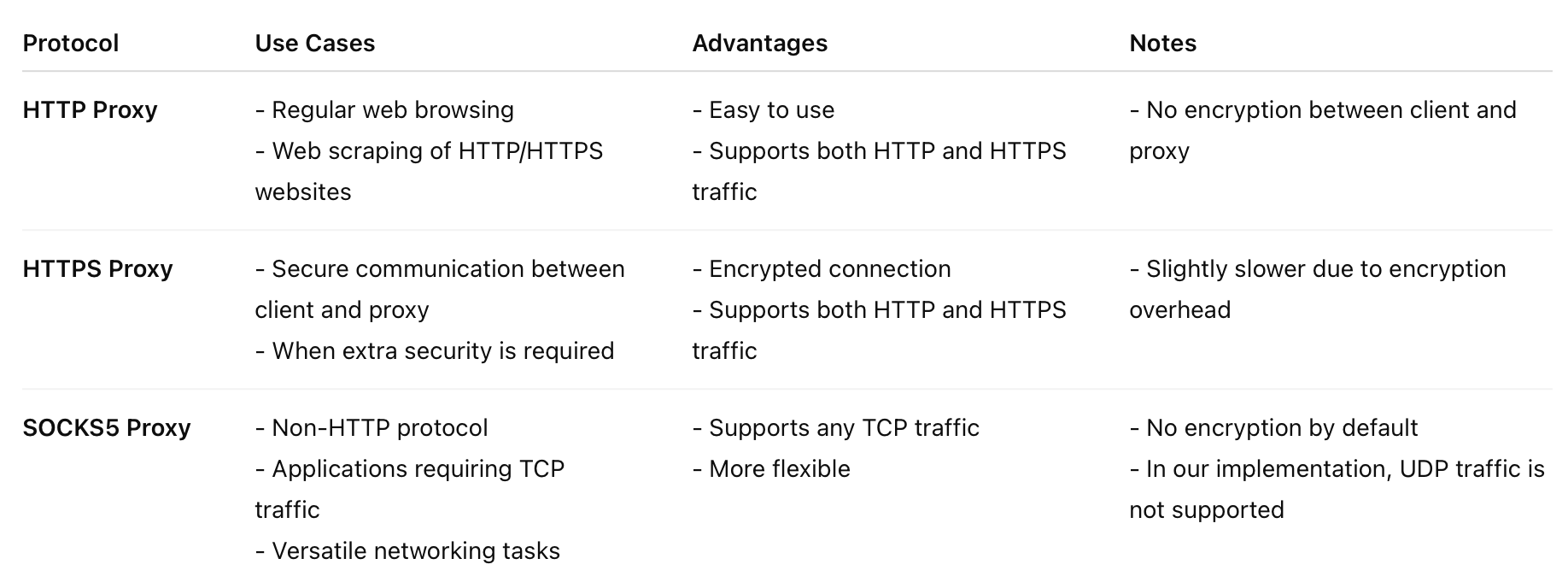1. HTTP Proxy
HTTP proxies are designed to handle HTTP traffic. They are widely used for web scraping, accessing HTTP websites, and regular web browsing. HTTP proxies can also handle HTTPS traffic via the HTTP CONNECT method, allowing you to access secure websites even when using an HTTP proxy.
Key Features:
- Supports HTTP and HTTPS traffic
- Commonly used for web scraping and browsing
- No encryption between client and proxy
2. HTTPS Proxy
HTTPS proxies add an extra layer of encryption between the client and the proxy server. While they also support both HTTP and HTTPS traffic, the communication between your device and the proxy is encrypted, providing enhanced security.
Key Features:
- Encrypted connection between client and proxy
- Supports HTTP and HTTPS traffic
- Slightly slower due to encryption overhead
💡Note: You don’t need an HTTPS proxy to access HTTPS websites. HTTP proxies can handle HTTPS traffic perfectly—and usually faster!
3. SOCKS5 Proxy
SOCKS5 proxies operate at a lower level and can handle any type of traffic, not just HTTP or HTTPS. They are more versatile and can be used for various types of network connections.
Key Features:
- Supports any TCP traffic
- More versatile than HTTP/HTTPS proxies
- No encryption by default
- Does not support UDP traffic (in our implementation)
Important: Our SOCKS5 proxies only support TCP traffic. UDP is not supported.
When to Use Each Protocol

Use an HTTP Proxy when:
- You need to access HTTP or HTTPS websites.
- Encryption between your device and the proxy is not a concern.
- You want a simple setup for web scraping or browsing.
Use an HTTPS Proxy when:
- You need encrypted communication between your device and the proxy.
- You are handling sensitive data and require additional security.
- You’re willing to trade a bit of speed for encryption.
Use a SOCKS5 Proxy when:
- You need a TCP proxy for non-HTTP protocols.
- You want a versatile proxy that can handle various types of TCP traffic.
- You understand that our SOCKS5 proxies do not support UDP traffic.
💡 Tip: For most HTTP and HTTPS traffic, an HTTP proxy is sufficient. You do not need an HTTPS proxy to access HTTPS websites.
Other Considerations
- Performance: HTTP proxies generally offer better performance than HTTPS proxies due to lower overhead.
- Security: HTTPS proxies provide encrypted connections, which are useful for transmitting sensitive data.
- Compatibility: SOCKS5 proxies are compatible with a wide range of applications but require proper configuration.
How to Configure a Proxy
Configuration steps vary depending on the application or programming language you’re using. In general, you will need to specify:
- Proxy Protocol (HTTP, HTTPS, or SOCKS5)
- Endpoint:
proxy.ipocto.com(same for HTTPS) - Port Number:
1000for HTTP proxy1001for HTTPS proxy1002for SOCKS5 proxy- Authentication Credentials: Your proxy username and password
Examples
HTTP Proxy Connection:
- Endpoint:
proxy.ipocto.com - Port:
1000 - Protocol: HTTP
HTTPS Proxy Connection:
- Endpoint:
proxy.ipocto.com - Port:
1001 - Protocol: HTTP
SOCKS5 Proxy Connection:
- Endpoint:
proxy.ipocto.com - Port:
1002 - Protocol: SOCKS5
💡Note: Make sure you are using the correct port number for the proxy protocol you are configuring.
